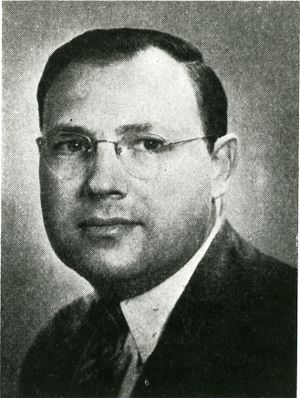Harold B. Law
- Birthdate
- 1911/09/07
- Birthplace
- Douds, IA, USA
- Associated organizations
- RCA (Radio Corporation of America)
- Fields of study
- Television
- Awards
- IEEE Lamme Medal, IEEE Vladimir K. Zworykin Award
Biography
Harold B. Law was born on September 7, 1911, in Douds, Iowa, but grew up in Kent, Ohio. He received B.S. degrees in Liberal Arts and in Education both in 1934, from Kent State University. He then earned M.S. and Ph.D. degrees in Physics in 1936 and 1941, respectively, from Ohio State University.
During his high school and undergraduate years, he was a glider enthusiast, both as a builder and flyer. He started at the local airport employing a rubber-rope catapult and "graduated" to a wire-cable auto tow that enabled him to attain an altitude of 1000 feet at the Akron, Ohio, airport. After graduating from Kent State, Dr. Law taught high school mathematics at Maple Heights, Ohio, from 1934 to l935 and at Toledo from 1931 to 1939.
He joined the RCA Corporation at Camden, New Jersey, in 1941, and in 1942 he transferred to the newly opened RCA Laboratories at the David Sarnoff Research Center in Princeton, N.J. He was named a Fellow of the Technical Staff in 1960, and in 1962 was appointed to his present position, Director of the RCA Electronics Components Materials and Display Device Laboratory.
Upon joining RCA, Dr. Law worked in the field of television camera tubes, hut he is primarily known for his research and innovations in the field of TV display tubes, both black-and-white and color. Dr. Law developed the fabrication techniques that made possible the manufacture of the shadow mask color TV tube, used in the vast majority of color television receivers throughout the world.
He invented a method that uses light to simulate electron rays for printing phosphor screens in shadow mask color tubes. His technique locates and fixes the phosphor elements precisely where they are needed on the faceplate to achieve independent excitation by electron beams of the red, green and blue emitting phosphors. In addition, he contributed to the focussing type color tube and scan enhancement as well as inventing the beam-reflector kinescope.
He also worked with Dr. Albert Rose and Dr. Paul K. Weimer, both of RCA Laboratories, in the development of the image orthicon camera tube. His contribution was the development of the glass-mesh target structure including a technique for making very fine high transmission metal meshes from a ruled glass master.
For their development of the image orthicon, Dr. Law and his colleagues received an award from the Television Broadcasters Association in 1946. In 1955, he was given the IEEE's Zworykin Television Prize and in 1966, the Consumer Electronics Outstanding Contribution Award of the National Electronics Conference.
Dr. Law has been given four RCA Laboratories Outstanding Achievement Awards for his research accomplishments. And, in 1961, he received RCA's highest technical honor, the David Sarnoff Outstanding Achievement Award "for team performance in making basic and practical contributions to the science of electron optics." He was the recipient of the 1975 IEEE Lamme Medal.
In addition to being a Fellow of the IEEE and of the Society of Information Display, Dr. Law is a member of the American Physical Society and Sigma Xi. He has been issued 38 U.S. Patents and has published 11 technical papers. Also, he is co-author pf a book. "Color Television Picture Tubes," published by Academic Press.
Dr. Law maintained interests outside of his work. His hobbies included photography, vegetable gardening, woodworking. and jogging.
He lived in Hopewell with his wife, the former Ruth Workman of Dennison, Ohio. A retired teacher, Mrs. Law earned a reputation as an unusually effective mathematics instructor in the intermediate grades because of a love for children and the subject.

